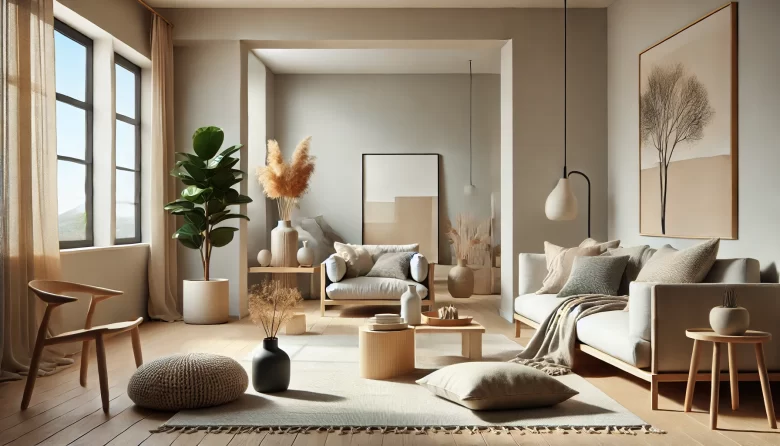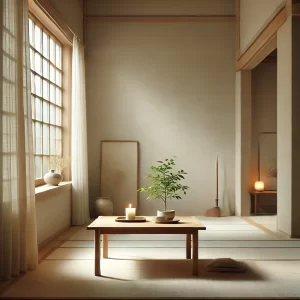Introduction
When it comes to designing a home or workspace, the idea of “less is more” has gained immense popularity. Over-decorating a space can lead to cluttered, chaotic environments that often don’t reflect personal style or meet functional needs. On the other hand, creating a practical and stylish interior with less decoration centers around simplicity, organization, and quality design. This approach helps to make your space feel more expansive, comfortable, and efficient without compromising on style. In this article, we’ll explore how to create a beautiful, functional, and serene interior by incorporating minimalist principles and thoughtful design choices.
Why Less Decoration Works
The concept of “less decoration” is not about leaving spaces bare but rather about embracing intentional design with fewer, more meaningful elements. By eliminating excess, you can create a space that feels more spacious, peaceful, and organized. Here’s why less decoration is an effective approach:
Simplicity Promotes Calmness
A minimalist space often evokes a sense of tranquility. Clutter is known to contribute to stress and anxiety, and a clean, organized space fosters a calming environment. This is particularly beneficial in areas meant for relaxation, like bedrooms and living rooms, where mental clarity and stress reduction are important.
Increased Functionality
The fewer items you have, the more freedom there is to incorporate furniture and décor that enhances the space’s functionality. Instead of filling up a room with unnecessary decorations, you can use that space for functional elements—seating, storage, and workspaces. This ensures that each item in the room serves a purpose.
Timeless Appeal
Simple, minimalist interiors tend to have a timeless quality. By focusing on neutral colors, clean lines, and functional pieces, your space remains stylish and relevant regardless of passing trends. This long-term approach reduces the need for constant updates and helps create a space that feels timeless.
Sustainability
By choosing quality items that will last longer, you contribute to a more sustainable lifestyle. The minimalist approach encourages thoughtful purchasing, which reduces unnecessary consumption. Fewer items mean less waste and fewer things that need to be discarded or replaced over time.
Key Principles for a Practical, Stylish Interior
When designing an interior with less decoration, it’s essential to embrace certain principles that will help create a functional yet aesthetically pleasing environment. Below are key guidelines for achieving a minimalist design:
Prioritize Functionality Over Decoration
Functionality should always come before decoration. When designing a room, think about its purpose and ensure that the furniture and layout support the room’s function. Consider whether each item in the room is serving a practical purpose. If it doesn’t, it might be time to let it go.
- Furniture Layout: Arrange furniture to encourage natural flow and movement. For example, in a living room, place seating in a way that encourages conversation while ensuring that everything is easily accessible.
- Storage Solutions: Choose multi-functional furniture pieces such as storage ottomans or beds with built-in drawers. These solutions help maintain a clutter-free space while providing necessary storage.
- Lighting: Lighting should not only enhance the aesthetic of the room but also its functionality. A well-lit workspace requires task lighting, while a cozy living area benefits from ambient lighting.
Embrace Neutral Color Schemes
Neutral color palettes form the perfect foundation for minimalist interiors. Colors like whites, beiges, grays, and soft pastels create a serene and clean atmosphere while making spaces feel more open and spacious. Neutral tones allow furniture, decor, and textures to stand out without overwhelming the room. Here are some tips for using neutral colors effectively:
- Layer Textures: Even in a neutral palette, you can add interest by using different textures. Incorporate materials such as wool, linen, and leather for a dynamic and sophisticated look.
- Accentuate with Color: Use color sparingly through smaller items such as pillows, rugs, and artwork to add visual interest and warmth. For instance, a bold red vase or a green throw pillow can serve as a focal point without disrupting the neutral theme.
Focus on Statement Pieces
Rather than filling the room with a variety of decorative items, select a few statement pieces that can become the focal point of the space. These could be:
- Artworks: A single large painting or sculpture can anchor a room, giving it a clear point of interest without cluttering the space with smaller items.
- Furniture: A well-designed piece of furniture, such as a unique coffee table, armchair, or bookshelf, can be both functional and visually striking. A standout piece of furniture can elevate the entire room.
Incorporate Natural Elements
Natural elements help create a balanced and calming atmosphere while keeping the space feeling fresh and alive. Incorporating plants, wood, and other natural materials into your design introduces warmth and texture without overcrowding the space. Here’s how you can do that:
- Indoor Plants: Choose low-maintenance plants like succulents, snake plants, or ferns that add greenery without much care. Placing plants in corners or on shelves can help liven up the space.
- Wood Accents: Wooden furniture or decorative accessories bring natural warmth to minimalist interiors. Opt for wooden tables, chairs, or shelving to create a cozy yet simple feel.
- Natural Fabrics: Fabrics like cotton, linen, and wool are natural, durable, and timeless. Use them in your upholstery, throw blankets, and pillows to bring texture and comfort to the room.
Keep Decorative Items Functional
To maintain a minimalist aesthetic while still incorporating decoration, opt for items that have both form and function. These pieces can enhance the room’s design while serving a practical purpose. Here are some ideas:
- Decorative Bowls: Use a stylish bowl for storing keys, coins, or other small items. This way, you get both functionality and decoration in one.
- Books: Books not only add visual appeal to shelves and tables, but they are also useful and timeless. A curated collection of books can serve as both decoration and an intellectual stimulus.
- Textiles: Soft furnishings like pillows, throws, and rugs can serve as functional items that provide comfort while also enhancing the room’s design.
How to Declutter and Simplify Your Space
Achieving a minimalist interior can be a challenge, especially if you’re used to having many decorative items in your space. Decluttering is a critical part of this process. The good news is that once you’ve simplified your space, it will be much easier to maintain a tidy and aesthetically pleasing environment. Here’s how you can get started:
Assess Your Needs
Before you begin decluttering, take a moment to assess the function of each room. Ask yourself: What is this room used for? What do I need in this space to support its function? This will help you determine which items are necessary and which can be removed.
Remove Excessive Decorative Items
Start by eliminating small, non-essential decorative items that don’t contribute to the overall design or function of the room. Knick-knacks, excess picture frames, and outdated decor can make a space feel crowded and cluttered. Remove these items to give your space a cleaner, more organized look.
Simplify Furniture Choices
Take a look at your furniture. Is every piece functional? Do any items crowd the space or serve no real purpose? Consider removing or repurposing furniture that you no longer need. This creates more room for movement and allows for more intentional design choices.
Create Designated Storage Areas
One of the keys to maintaining a minimalist interior is ensuring that every item has a designated place. Invest in storage solutions such as baskets, shelves, or cabinets that keep your belongings neatly organized but still accessible.
Maintain a Routine
Once you’ve simplified your space, it’s essential to establish a regular routine of cleaning and decluttering. This will prevent things from piling up again and help keep your space looking fresh and organized. Regularly assess your belongings and make sure that anything you no longer use is removed.
Decorating with Less: A Practical Guide
Decorating with less doesn’t mean your home has to feel sterile or devoid of personality. It simply means making thoughtful choices about what to keep in the space. Here’s a step-by-step guide for decorating with fewer items:
- Choose Functional Furniture: Invest in high-quality, versatile furniture that serves both practical and aesthetic purposes. Look for pieces that are functional and can be used in multiple ways.
- Limit the Number of Accessories: Keep your accessories to a minimum. Focus on quality over quantity, choosing pieces that enhance the space without creating visual clutter.
- Use Large-Scale Art or Mirrors: A large painting or mirror can serve as a dramatic focal point without overwhelming the space.
- Add Texture: Mix and match various textures through your textiles (such as pillows, throws, and curtains). This adds warmth and visual interest without the need for excessive decoration.
- Consider Open Shelving: If you want to display items, opt for open shelving where you can curate a collection of meaningful pieces. This creates an elegant and intentional display without cluttering the space.
Conclusion
Creating a practical and stylish interior with less decoration is all about embracing simplicity without sacrificing style. By prioritizing functionality, using neutral color schemes, incorporating statement pieces, and minimizing unnecessary items, you can design a space that feels more spacious, organized, and welcoming. Less decoration doesn’t mean boring—it means creating a thoughtful, well-curated environment that reflects your personality while maintaining a sense of calm and order. Whether you’re designing a small apartment or a large home, minimalist principles can be applied to any space, helping you create a beautiful environment that is both practical and aesthetically pleasing.
Through thoughtful design choices, you can transform your interior into a peaceful, stylish sanctuary that fosters comfort, organization, and creativity. Remember: less really can be more—when done with intention.




